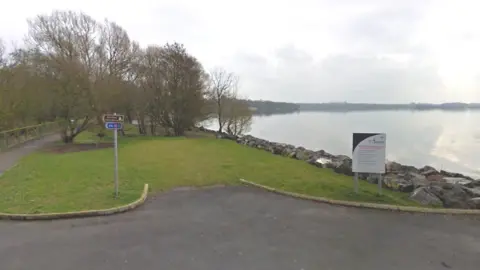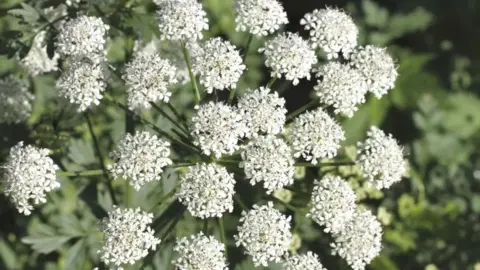Lough Neagh: Dog owners warned of poisonous algae and plant
 Google
GoogleDog owners have been warned of a poisonous algae and toxic plant on the Lough Neagh shoreline in Antrim.
Tests were carried out near Rea's Wood following a report that a dog had died after it had been in the water.
The Northern Ireland Environment Agency was alerted to the pet's death on 19 May.
It carried out a number of tests over several days to investigate evidence of algal bloom.
Antrim and Newtownabbey Borough Council said a sample taken on Tuesday confirmed small amounts of an algae called Microcystis sp had washed up on the shoreline.
Microcystis sp is a blue-green algae that can produce toxins which are highly poisonous and often fatal to pets.
'Most poisonous indigenous plant'
The council said a large amount of the toxic but fairly common plant hemlock water dropwort was also seen growing in the wooded area along Rea's Wood.
In a safety update posted online, it stated: "Hemlock water dropwort (poison parsnip) is perhaps the most poisonous indigenous plant in Britain and Ireland.
 Getty Images
Getty Images"This is a native plant, not an invasive species, and it grows mostly in wet meadows along river courses and adjacent to lakes.
"It is highly toxic to humans and domesticated animals if ingested - although the roots are more toxic than the above-ground parts."
The council has erected new signs warning the public of the toxic plant and algae, and advising dog owners keep their pets on leads at all times.
"Dog owners should always be aware of the dangers posed by all poisonous plants and algae growing in the environment, but especially along riverbanks and in wet grassland or edges of lakes," the council said.
 Getty/Olga Pankova
Getty/Olga PankovaLast year, following the deaths of three dogs in the area, the council and Northern Ireland Environmental Agency carried out investigations.
It found no evidence that the dogs were poisoned as a result of contact with water in Lough Neagh.
Jim Gregg of the Sixmilewater Trust told BBC Newsline "whatever killed the dogs" last year was never firmly established.
He said that as a member of the trust he had been on site after one of the dogs had died and came across what he thought was an algae washed up on the foreshore.
Mr Gregg said that if he was a dog owner, he would not be wanting to bring the dog into the area "at this present time".
"Having said that, blue-green algae is naturally occurring throughout the environment, so you can't keep dogs in forever, but there will be certain times of the year I would say it would be prudent to maybe take more care and caution - from May through to September."
